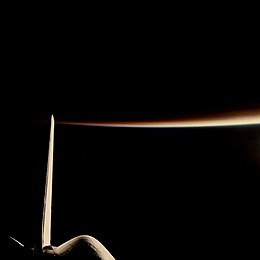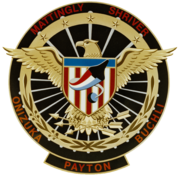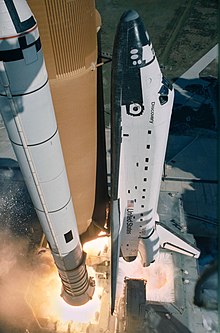 Discovery in orbit; in-flight photography of the Department of Defense support mission is limited. Discovery in orbit; in-flight photography of the Department of Defense support mission is limited. | |
| Names | Space Transportation System-15 |
|---|---|
| Mission type | DoD satellite deployment |
| Operator | NASA |
| COSPAR ID | 1985-010A |
| SATCAT no. | 15496 |
| Mission duration | 3 days, 1 hour, 33 minutes, 23 seconds |
| Distance travelled | 2,010,000 km (1,250,000 mi) |
| Orbits completed | 49 |
| Spacecraft properties | |
| Spacecraft | Space Shuttle Discovery |
| Launch mass | 113,802 kg (250,890 lb) |
| Landing mass | (Classified) |
| Payload mass | (Classified) |
| Crew | |
| Crew size | 5 |
| Members | |
| Start of mission | |
| Launch date | January 24, 1985, 19:50:00 (January 24, 1985, 19:50:00) UTC (2:50 pm EST) |
| Launch site | Kennedy, LC-39A |
| Contractor | Rockwell International |
| End of mission | |
| Landing date | January 27, 1985, 21:23:23 (January 27, 1985, 21:23:23) UTC (4:23:23 am EST) |
| Landing site | Kennedy, SLF Runway 15 |
| Orbital parameters | |
| Reference system | Geocentric orbit |
| Regime | Low Earth orbit |
| Perigee altitude | 332 km (206 mi) |
| Apogee altitude | 341 km (212 mi) |
| Inclination | 28.45° |
| Period | 91.30 minutes |
 STS-51-C mission patch  Back row: Payton, Buchli and Onizuka Front row: Shriver and MattinglySpace Shuttle program← STS-51-A (14)STS-51-D (16) → | |
STS-51-C (formerly STS-10) was the 15th flight of NASA's Space Shuttle program, and the third flight of Space Shuttle Discovery. It launched on January 24, 1985, and made the fourth shuttle landing at the Shuttle Landing Facility at the Kennedy Space Center in Florida on January 27, 1985. STS-51-C was the first shuttle mission dedicated to the United States Department of Defense (DoD), and consequently many details remain classified. NASA reported that a satellite (USA-8) was deployed during the mission using an Inertial Upper Stage booster was deployed and met mission objectives. At just over three days, the mission was shorter in duration than most civilian missions and was the shortest of Discovery's career.
Crew
| Position | Astronaut | |
|---|---|---|
| Commander | Ken Mattingly Third and last spaceflight | |
| Pilot | Loren Shriver First spaceflight | |
| Mission Specialist 1 | Ellison Onizuka Only spaceflight | |
| Mission Specialist 2 Flight Engineer |
James Buchli First spaceflight | |
| Payload Specialist 1 | Gary Payton, MSE Only spaceflight | |
Backup crew
| Position | Astronaut | |
|---|---|---|
| Payload Specialist 1 | Keith Wright, MSE | |
Crew seat assignments
| Seat | Launch | Landing |  Seats 1–4 are on the flight deck. Seats 5–7 are on the mid-deck. |
|---|---|---|---|
| 1 | Mattingly | ||
| 2 | Shriver | ||
| 3 | Onizuka | ||
| 4 | Buchli | ||
| 5 | Payton | ||
| 6 | Unused | ||
| 7 | Unused | ||
Mission summary

STS-51-C launched from Kennedy Space Center (KSC) on January 24, 1985, at 19:50:00 UTC, and was the first of nine shuttle missions in 1985. It was originally scheduled for January 23, 1985, but was delayed because of freezing weather. Challenger had been scheduled for this flight, but Discovery was substituted when problems were encountered with Challenger's thermal protection tiles. STS-51-C marked the 100th human spaceflight to achieve orbit.
The mission's length of three days was shorter than the week or longer of most civilian shuttle flights. It was the first dedicated to the U.S. Department of Defense (DoD), and most information about it remains classified. For the first time, NASA did not provide pre-launch commentary to the public until nine minutes before liftoff. The U.S. Air Force only stated that the shuttle successfully launched its payload with an Inertial Upper Stage (IUS) on the mission's seventh orbit. It is believed that the payload was a Magnum SIGINT satellite into geosynchronous orbit. Other DoD flights STS-33 and STS-38 could have carried similar payloads. Payton stated in 2009 that STS-51-C's payload is "still up there, and still operating". Payton was a USAF Manned Spaceflight Engineer (MSE); the USAF declined a NASA offer to fly another MSE on the mission.
Also, according to Aviation Week, the shuttle initially entered a 204 × 519 km (127 × 322 mi) orbit, at an inclination of 28.45° to the equator. It then executed three Orbital Maneuvering System (OMS) burns, the last being executed on the fourth orbit. The first burn was conducted to circularize the shuttle's orbit at 519 km (322 mi).
The mission lasted 3 days, 1 hour, 33 minutes, and 23 seconds. Discovery touched down on SLF Runway 15 at KSC on January 27, 1985, at 21:23:23 UTC. IMAX footage of the STS-51-C launch was used in the 1985 movie The Dream is Alive.
Mission insignia
The crew insignia for STS Flight 51-C includes the names of its five crewmembers. The STS 51-C mission marked the third trip of the Space Shuttle Discovery into space, which is referenced by the three colored trailing strips behind the orbiter in the United States red, white and blue. It was the first Space Shuttle mission totally dedicated to the U.S. Department of Defense, hence the DoD central eagle on the mission patch. The five stars on the upper part of the golden band of the DoD insignia represent the five astronauts. As this mission was classified, the patch includes no further detail as to the mission's payload or nature. For similar reasons, the name of the used orbiter was omitted from the patch.
Connection to the Challenger disaster
Almost exactly a year after STS-51-C, Space Shuttle Challenger was destroyed with all hands on board during the STS-51-L mission including Ellison Onizuka, a crew member on both flights. As part of the investigation into the disaster, it was reported to the Rogers Commission that during the launch of STS-51-C, the worst Space Shuttle Solid Rocket Booster (SRB) blow-by effects of any mission prior to STS-51-L occurred, indicating conclusively that the Viton O-rings were not sufficiently sealing the hot gases inside the combustion chambers of the SRBs while firing. After they were recovered post-flight, the O-rings in both the right and left SRBs showed some degree of charring, but analysis of the center field joint of the right SRB showed an unprecedented penetration of the primary O-ring and heavy charring on the secondary O-ring.
This information is significant to the established consensus that low air temperature was a major factor in Challenger's destruction because the temperature at STS-51-C's launch was also, up to its time, the coldest recorded during a shuttle launch, at only 12 °C (54 °F).
See also
References
- "SATCAT". Jonathan's Space Report. Retrieved March 24, 2014.
- "STS-51C". Spacefacts. Retrieved February 26, 2014.
- Blakeslee, Sandra (October 8, 1985). "Astronauts return from secret". The New York Times. ISSN 0362-4331.
- Vick, Charles (June 27–28, 2007). "MAGNUM-ORION NRO/CIA/NSA, SIGINT spacecraft". Global Security. Retrieved January 17, 2021.
- Cassutt, Michael (August 2009). "Secret Space Shuttles". Air & Space magazine. Retrieved April 18, 2015.
- Cassutt, Michael (January 1989). "The Manned Space Flight Engineer Programme". Spaceflight. Archived from the original on December 30, 2008.
- ^ Rogers Commission Report (1986). "Report of the Presidential Commission on the Space Shuttle Challenger Accident, Volume 1, Chapter 6". NASA.
 This article incorporates text from this source, which is in the public domain.
This article incorporates text from this source, which is in the public domain.
External links
- NASA mission summary Archived October 16, 2008, at the Wayback Machine
- STS-51-C In-flight Photographs at the National Archives and Records Administration
| Space Shuttle Discovery (OV-103) | ||
|---|---|---|
| Completed flights |  | |
| Status |
| |
| On display | ||
| Related |
| |
| U.S. Space Shuttle missions | |||||||||||
|---|---|---|---|---|---|---|---|---|---|---|---|
| Completed (crews) |
| ||||||||||
| Cancelled | |||||||||||
| Orbiters | |||||||||||
| |||||||||||